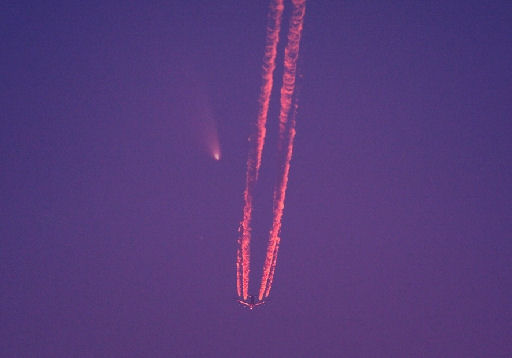CME IMPACT: As expected, a coronal mass ejection (CME) hit Earth's magnetic field on March 15th at approximately 0500 UT. The impact was weak, but conditions for geomagnetic storming could develop as Earth passes through the CME's wake. High latitude sky watchers should be alert for auroras on March 15th and 16th. Aurora alerts: text, voice.
POSSIBLE EARTH-DIRECTED CME: A magnetic filament snaking around sunspot AR1692 erupted on March 15th at about 0600 UT. The slow explosion, which took hours to unfold, produced an M1-class solar flare and a bright CME. SOHO (the Solar and Heliospheric Observatory) captured the CME just as it was leaving the sun:
The central location of the explosion combined with multiple views of the CME from SOHO and NASA's twin STEREO spacecraft suggest that the cloud is heading almost directly toward Earth. If so, an impact would likely occur in 2 to 3 days, setting the stage for weekend auroras. Stay tuned for refined estimates of the arrival time. Aurora alerts: text, voice.
Realtime Space Weather Photo Gallery
THE MAGNITUDE OF COMET PAN-STARRS: "There seem to be a lot of pictures, but a shortage of magnitude estimates for Comet Pan-STARRS," says Richard Keen, professor of atmospheric sciences at the University of Colorado. "I saw it for the first time this evening, and got a magnitude estimate before the comet slipped behind a narrow cloud bank." Keen is an expert observer of astronomical brightness, especially that of lunar eclipses which he uses to study aerosols in the stratosphere. "The comet is magnitude +0.2 with a short, but bright vertical tail. It was quite visible to the unaided eye. After the [head of the comet] set behind the mountains, the tail was visible for two or three more minutes."
A growing number of observers say they can see the comet with their unaided eye. Here it is on March 14th at sunset over Valley Forge, PA:
"The comet looked fantastic through my 10x70 Fujinon binoculars, and it was barely visible to the naked eye," says photographer John Chumack. Note: "Barely visible" is an improvement over recent nights.
Visibility should continue to improve in the nights ahead as Pan-STARRS moves away from the sun. Keen's magnitude estimate of +0.2 means that the comet is approximately twice as bright as a first magnitude star. When it is framed by darker skies, it will really stand out. Tonight when the sun goes down, step outside, face west, and take a look: sky map.
More: NASA video, 3D orbit, ephemeris, light curves.
Realtime Noctilucent Cloud Photo Gallery
[previous years: 2003, 2004, 2005, 2006, 2007, 2008, 2009, 2011]
Potentially Hazardous Asteroids (PHAs) are space rocks larger than approximately 100m that can come closer to Earth than 0.05 AU. None of the known PHAs is on a collision course with our planet, although astronomers are finding new ones all the time.
![]()
![]()
Recent & Upcoming Earth-asteroid encounters:
Asteroid
![]()
Notes: LD means "Lunar Distance." 1 LD = 384,401 km, the distance between Earth and the Moon. 1 LD also equals 0.00256 AU. MAG is the visual magnitude of the asteroid on the date of closest approach.

![]()
Solar wind
speed: 436.8 km/sec
density: 3.5 protons/cm3
explanation | more data
Updated: Today at 1906 UT
![]()
X-ray Solar Flares
6-hr max: C1 1518 UT Mar15
24-hr: M1 0703 UT Mar15
explanation | more data
Updated: Today at: 1900 UT
![]()
![]()
![]()
Daily Sun: 15 Mar 13
![]()
![]()
Sunspot AR1692 was involved in an M1-class sola flare on March 15th. Solar activity is picking up. Credit: SDO/HMI
![]()
![]()
![]()
Sunspot number: 133
What is the sunspot number?
Updated 15 Mar 2013
Spotless Days
Current Stretch: 0 days
2013 total: 0 days (0%)
2012 total: 0 days (0%)
2011 total: 2 days (<1%)
2010 total: 51 days (14%)
2009 total: 260 days (71%)
Since 2004: 821 days
Typical Solar Min: 486 days
Update 15 Mar 2013
The Radio Sun
10.7 cm flux: 123 sfu
explanation | more data
Updated 15 Mar 2013
![]()
![]()
![]()
Current Auroral Oval:
![]()
Switch to: Europe, USA, New Zealand, Antarctica
Credit: NOAA/POES
![]()
![]()
![]()
Planetary K-index
Now: Kp= 1 quiet
24-hr max: Kp= 3 quiet
explanation | more data
![]()
Interplanetary Mag. Field
Btotal: 5.8 nT
Bz: 4.3 nT north
explanation | more data
Updated: Today at 1907 UT
![]()
![]()
![]()
Coronal Holes: 15 Mar 13
![]()
![]()
Solar wind flowing from this coronal hole could reach Earth on March 19-20. Credit: SDO/AIA.






